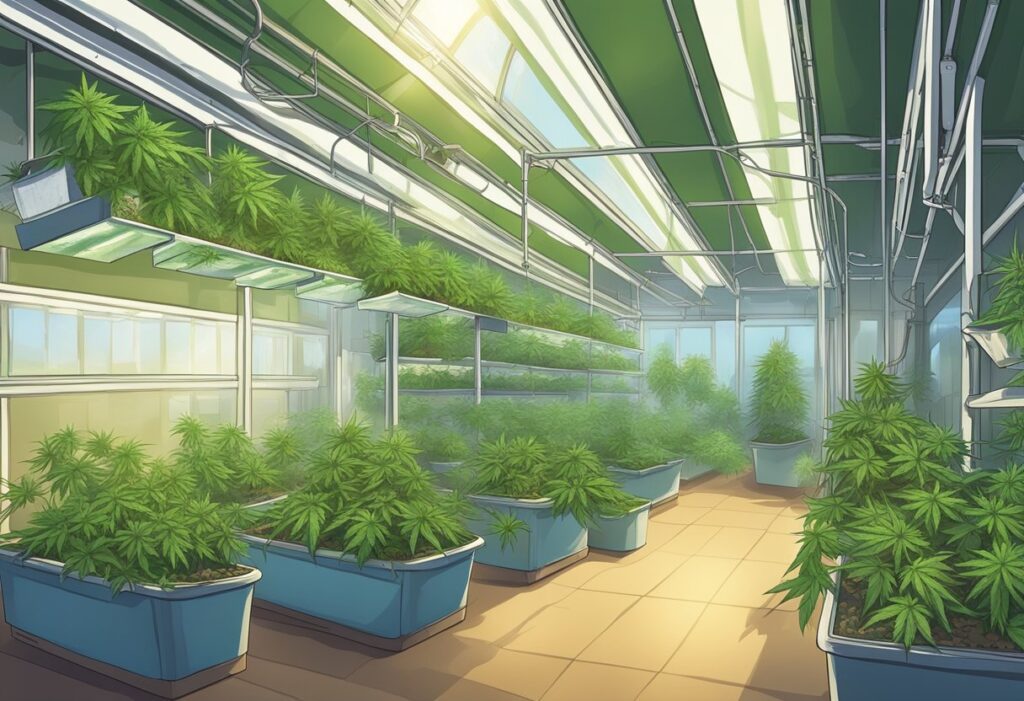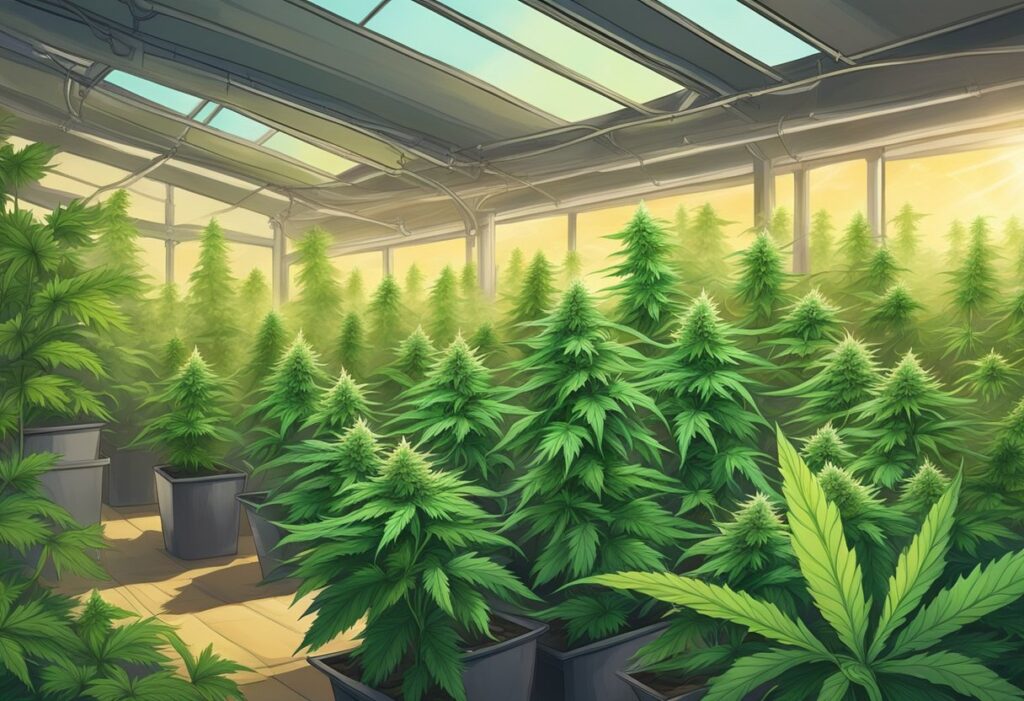
Autoflowering cannabis strains have unique perks for your cultivation adventures, particularly within the variable Canadian weather conditions. They offer a predictable growth cycle and adaptability, which is key for both indoor and outdoor growing environments.
The climate in Canada can be a limiting factor for traditional cannabis strains with rigid requirements for sunlight and warmth. Autoflowering cannabis, however, has the tenacity to handle shorter, cooler summers. Your autoflower plants will go from seed to harvest regardless of fluctuating temperatures because they’re not dependent on light cycles.
Autoflowering plants combine genetics from Cannabis sativa, Cannabis indica, and a hardy species known as Cannabis ruderalis. This unique blend endows autoflowers with a life cycle that doesn’t sync with sunlight patterns, allowing them to flower after a set period. Your autoflowering cannabis will switch to the blooming stage without nudging from light alterations, which is a boon when dealing with Canada’s diverse light availability.
Your autoflowering plants will exhibit a swift growth pattern, spreading their roots and sprouting within 1-2 weeks. They enter the seedling stage for another 2-3 weeks, setting up their initial true leaves. The vegetative stage endures for about 2-4 weeks, with the entire life cycle wrapping up in a rapid 8-10 weeks, ideal for beating any early onset of Canadian cold weather.
With autoflowering cannabis seeds, you have the flexibility to grow in variable Canadian climates while still ensuring a timely and successful harvest, be it in the controlled environment of your home or the natural embrace of the great outdoors.

When cultivating autoflowering plants in Canada, you must tailor your techniques to suit the indoor or outdoor growing environments. Your practices impact the yield and quality of your harvest.
For indoor cultivation, select a soil mix that drains well and is rich in organic matter. Your autoflowering plants need a balanced mix of nutrients, typically lower in nitrogen, to avoid overfeeding. Watering should be moderate, as overwatering can lead to root issues.
Outdoor growers face more variability in soil quality. You should enhance your garden soil with compost and ensure proper drainage. Nutrient needs must be monitored more closely due to environmental factors. Watering can be less frequent if rain provides natural irrigation, but be vigilant during dry spells.
Indoor setups require an investment in quality LED or HID lamps, as consistent light is key. Autoflowers thrive at a temperature range of 20–25°C. An 18/6 or 20/4 light cycle is recommended to balance energy consumption with optimal growth.
For outdoor growing, plants depend on the sun’s cycle. While less controllable, it’s crucial to protect your plants from temperature extremes. In Canada, autoflowers are beneficial because they don’t rely on changing light cycles to flower, thus adapting to shorter grow seasons.
Indoors, maintaining a clean environment is essential to prevent infestations. Regularly inspect your plants for signs of pests or diseases. Introduce beneficial insects if needed or apply organic pest control measures.
Outdoors, you face a broader range of pests and diseases. Use companion planting and natural repellents to protect your autoflowers. Act quickly if you detect any issues, as outdoor plants are more exposed to the elements which can accelerate problems.
Determining the right time to harvest is crucial. Trichome examination under a microscope will tell you when your autoflowers are at their peak cannabinoid production. For indoors, ensure all equipment is sterile to maintain quality. Outdoors, plan to harvest on a dry day to prevent mold.
When cutting your plants, hang them upside down in a well-ventilated, dark space with controlled humidity. Proper drying and curing will enhance the quality and yield of your final product. Remember, gentle handling preserves trichomes and potency.

Autoflower cannabis plants offer you the convenience of quick harvests and smaller sizes, which can be particularly advantageous in Canada where the growing season is short. The right strategies in selecting strains, training, and post-harvest processes are key to boosting both the quality and quantity of your yield.
It’s essential to start your grow with an autoflowering strain that is not only robust but also well-suited to the climatic conditions of Canada. Look for feminized autoflowering seeds which assure almost 100% flowering plants, resulting in better use of space and resources. Choose strains known for their potent THC levels, rich terpene profiles, and compatibility with indoor or outdoor setups, depending on your preference.
Employing low-stress training (LST) techniques such as bending and tying can increase light exposure and improve air flow around your plants. This can encourage your autoflowers to develop a more even canopy and multiple bud sites, which can lead to higher yields. Avoid high-stress techniques which can stunt the growth of autoflowering plants, as they have a shorter vegetative stage.
Timing your harvest is crucial for maximizing the THC and terpene content of your autoflower cannabis. The flowering stage of autoflowers is shorter, so monitor your plants closely. Harvest when the trichomes are milky for peak THC levels or wait until they are amber for a more relaxing effect. Harvesting too early or too late can compromise the quality of your cannabis.
After harvesting, proper drying and curing will enhance the flavors and overall quality of your cannabis. Dry your buds slowly in a controlled environment to prevent mold and preserve terpenes. Curing in airtight containers, usually for a few weeks, allows the cannabinoids and terpenes to mature, which can significantly enhance the potency and flavor profile of your yield.
Indoor cultivation provides you more control over environmental factors like temperature and humidity, which can lead to consistent growth and potentially higher yields compared to outdoor cultivation. However, growing autoflowers outdoors in Canada lets you take advantage of natural sunlight and can be more cost-effective, despite the shorter growing season due to climate considerations.
The yield of indoor-grown autoflowers typically surpasses that of outdoor cultivation, as you can optimize the light schedule, often with 18-20 hours of light per day. Outdoor yields may be less due to varying light conditions and other environmental factors, but with autoflowers’ fast growth cycle, you can still achieve multiple harvests in a season.
To successfully transition autoflowers from indoor to outdoor conditions, acclimate your plants gradually to the natural sunlight and temperature changes. Start by placing them outside for a few hours each day during a warm period, slowly increasing their outdoor time to avoid stress or shock.
Autoflowers grow best outdoors in a temperature range of approximately 15°C to 25°C. In Canada, this typically means planting after the last frost of spring and being ready to harvest before the temperatures drop in early fall.
Outdoor autoflowers in Canada should be harvested when they have fully matured, which is usually evident when the majority of trichomes turn cloudy white and pistils darken and curl. This typically occurs 7-10 weeks after planting, but always check your specific strain’s guidelines.
We ship and deliver world wide via USPS and various couriers.
We offer a wide range of secure and anonymous online payment options.
We care about you, our customer. Please contact us with any questions or concerns.
Find out more about the benefits of being a loyal and regular customer.
WE ARE EVERY GROWERS ONE STOP SHOP TO ACQUIRE PREMIUM CANNABIS SEEDS FOR SALE IN THE USA, CANADA AND AUSTRALIA

Farmers Lab Seeds 2024, | All Right Reserved
Seeds are sold as novelty items, souvenirs, and collectibles. They contain 0% THC. We encourage our customers to check the legislation in their Country, State, Province, and Municipality prior to purchasing items from our store. We do not provide growing information.
All seeds are sold as hemp, and lab tested under 0.3% THC. This product is not for use by or sale to persons under the age of 21. This product should be used only as directed on the label. It should not be used if you are pregnant or nursing. Consult with a physician before use if you have a serious medical condition or use prescription medications. A Doctor’s advice should be sought before using this and any supplemental dietary product. All trademarks and copyrights are property of their respective owners and are not affiliated with nor do they endorse this product.
These statements have not been evaluated by the FDA. This product is not intended to diagnose, treat, cure or prevent any disease. Individual weight loss results will vary. By using this site, you agree to follow the Privacy Policy and all Terms & Conditions printed on this site. Void Where Prohibited by Law.